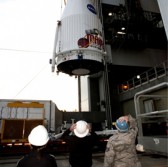 Lockheed Martin‘s Mars Atmosphere and Volatile Evolution spacecraft has captured the first ultraviolet images of solar energetic particle activity and a layer of ozone in Mars’ atmosphere as part of a mission for NASA.
Lockheed Martin‘s Mars Atmosphere and Volatile Evolution spacecraft has captured the first ultraviolet images of solar energetic particle activity and a layer of ozone in Mars’ atmosphere as part of a mission for NASA.
The space agency said Tuesday it is currently testing the spacecraft’s instruments ahead of the science mission, which will also study the possible causes of the planet’s loss of atmosphere, including the occurrence of coronal mass ejections of SEPs.
“After traveling through interplanetary space, these energetic particles of mostly protons deposit their energy in the upper atmosphere of Mars,” explained Davin Larson, SEP instrument lead from the University of California in Berkeley.
NASA said the team observed a CME on Sept. 26 and predicted the SEPs would have reached the Martian upper atmosphere three days later, after which the team began monitoring atmospheric response using an imaging ultraviolet spectrograph.
It noted that atoms near the planet’s surface escape to space through this upper atmosphere of hydrogen and oxygen and absorb ultraviolet sunlight, which affects the ozone and leads to climate change.
“The observations support our current understanding that the upper atmosphere of Mars, when compared to Venus and Earth, is only tenuously bound by the Red Planet’s weak gravity,” said Mike Chaffin, member of the MAVEN remote sensing team from the University of Colorado in Boulder.
The Lockheed-built MAVEN entered Martian orbit in late September to prepare for the primary science mission in November.




